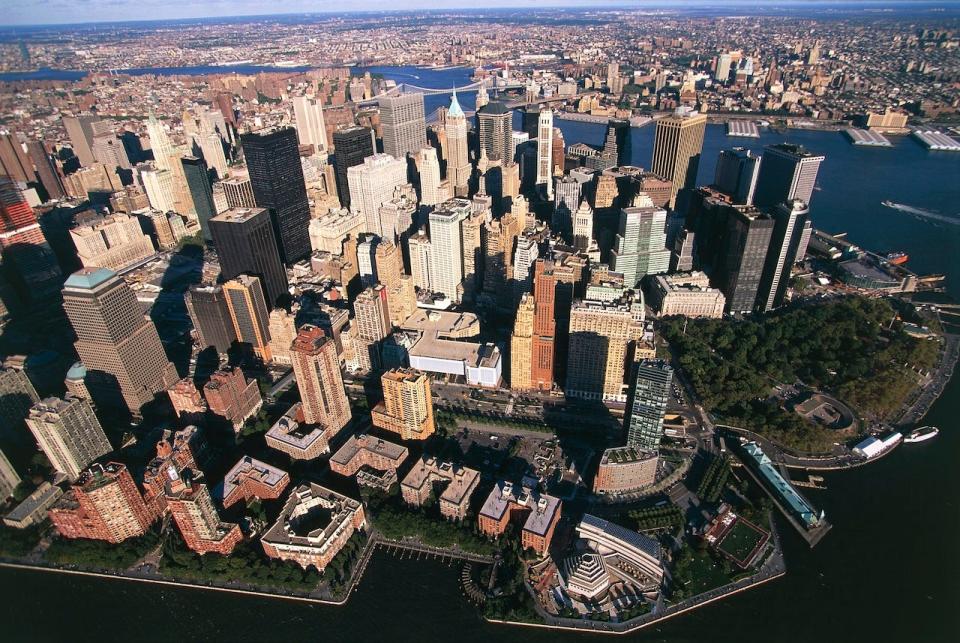New York tech workers make $135,000 on average, but can't afford the vast majority of apartments on the market

Rents in New York City rose more than seven times as fast as wages last year.
A new report says tech workers earning $135,089 annually could only afford 35% of rentals in the city.
As tech workers flood into the city, housing supply and high costs strain affordability for all.
Housing costs in New York have long been unaffordable. But the Big Apple is breaking the worst kinds of records these days.
Rents rose more than seven times as fast as wages last year. Plus, more than half of New Yorkers are rent-burdened, meaning they pay more than 30% of their before-tax income for housing. One in three tenants spend more than half of their income on rent, while homelessness has spiked.
Things are so bad that even tech workers, who make some of the highest salaries of any profession, are feeling the crunch. Tech workers earning the industry's average salary of $135,089 a year could only afford — defined as spending up to 30% of gross income on housing and upfront costs — 35% of rentals on the market in New York City last year, according to a report published on Tuesday from the rental platform StreetEasy and industry group Tech:NYC.
Almost 90% of NYC's tech jobs are located in Manhattan, where rents are steepest. In that borough, the median asking rent last year was $4,000 — and $3,500 for studios and one-bedrooms. Entry-level tech workers made an average of $75,262 in 2023, and could only afford 2.1% of studio and one-bedroom rental apartments in the city, StreetEasy found. In Manhattan, that number drops to 0.6% of studios and one-bedrooms.
"The crunch around housing is incredibly widely felt," Julie Samuels, the president and executive director of Tech:NYC, told Business Insider. "If these tech employees can't afford housing, then who can?"
Tech workers — defined in the report as those in computer and mathematical occupations — make the third-highest average annual wages among occupational groups in the city, according to the New York State Department of Labor.
Meanwhile, those who work in management positions could afford 71.5% of rentals on the market last year, while those in legal jobs could afford 64.7% of rentals.
New York City has seen a surge of growth in tech jobs over the last decade-plus, encouraged in part by government programs designed to boost tech education and welcome tech companies into the city. Despite many remote workers leaving New York during the pandemic, tech workers have resumed flooding into the city, including from hubs like San Francisco, in part to enjoy New York's lively social scene. But even as New York City has created 800,000 new jobs in the last 10 years, it's only built 200,000 new homes.
Samuels said she hears from tech companies concerned that many of their younger employees, particularly those who have kids, can't afford to stay in the city. "People who work in tech really want to live in New York," she said. "That drives the companies here as well, so that they can hire those people who want to live there. But if the people who want to live here can't afford to live here, that cycle gets messed up."
Of course, lower-income New Yorkers are being hit much harder by the housing crisis. The average tech worker makes 52% more per year than the average worker in New York City, the StreetEasy report noted.
New Yorkers who make the city's average wage could afford fewer than 5% of rentals on the market last year, according to the StreetEasy report.
Those in healthcare support jobs and food serving and preparation could afford the fewest homes. Half of the 22 occupation groups measured in the report could afford fewer than 1% of rentals on the market.
"Essential workers earning average wages in their occupations — for example, firefighters, transportation workers, nurses, and homecare aides — they could afford less than 1% of the rentals in the city in 2023," Kenny Lee, a senior economist at StreetEasy and the author of the report, told Business Insider.
Moving within the city is out of the question for many. To begin with, there are shockingly few homes even on the market — the city's home vacancy rate is just 1.4%, the lowest in over 50 years, according to a recent city report. And if someone is lucky enough to find a rental they can afford, up-front costs — including brokers' fees, security deposits, and first months' rent — have also soared. The average New Yorker moving homes spent $10,454 on upfront costs last year, not including hiring movers.
New York City Mayor Eric Adams and New York State Governor Kathy Hochul have declared the housing affordability crisis a central priority for their administrations. But neither has had much success in implementing solutions so far. Hochul's plan to encourage the construction of about 800,000 new homes across the state failed in the state legislature last year. It was brought down in part by local leaders in New York City's suburbs, who strongly oppose building more multi-family housing in their extremely low-density communities.
But Hochul has managed to find agreement with the legislature on a new version of her housing proposal that excludes the suburbs, but loosens restrictions on home construction and boosts protections for tenants.
Adams last year unveiled his "City of Yes" plan, which calls for a slew of zoning reforms to incentivize more and denser housing construction — and would create 100,000 new homes for 250,000 New Yorkers over 15 years. In its report, StreetEasy and Tech:NYC endorse Adams' plan, and call for even looser restrictions on housing density.
Read the original article on Business Insider

 Yahoo Finance
Yahoo Finance 